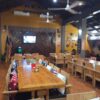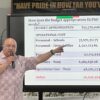
Agat Cemetery, Guam. Navy Color Guard stands by the half-masted flag, during Memorial Day ceremonies, 30 May 1945.
Contributed photo
THE Chamorros of Guam were well aware of Memorial Day, having celebrated it alongside American military personnel before the war. However, in May 1945, their minds were focused on recovering from the massive damage done to their lives by the American recapture of the island less than a year before, not to mention the dynamics of the continuing war with Japan. They were grateful for their salvation from the Japanese occupation, but still living in temporary thatched-roof homes, while mourning the hundreds of friends and family who had died as a result of the pre-war sacrifice of Guam to the Japanese.
The American military personnel on Guam were also aware of Memorial Day, but other events also consumed their thoughts.
On two consecutive days that week, between May 23 and 26, the morning skies over Guam were filled with the sights and sounds of hundreds of B-29s taking off from Guam’s two airfields, North Field and Northwest Field, headed north. Major General Curtis LeMay had ordered B-29s from Guam, Tinian, and Saipan to bomb Tokyo. On the night of May 23-24, 558 B-29 Superfortresses took to the skies and attacked the Tokyo industrial area. It has been labeled the “toughest” mission flown by the 20th Air Force. Yet, after receiving photos from his reconnaissance aircraft, LeMay was dissatisfied with the results.
On the night of May 25-26, 464 Superforts successfully returned to Tokyo. This time, their incendiary bombs started a conflagration that burned out seventeen square miles of Tokyo. Japan’s capital city was removed from the target list. Although forty-three B-29s had been lost and 169 damaged on the two missions, 22.1 square miles of Tokyo had been burned out, and 300,000 Japanese had been left homeless. LeMay was satisfied. Tokyo was removed from the target list. Yokohama took its place at the top of the list. The war continued.
LeMay wasted no time. On Tuesday, May 29, 1945, 454 B-29s dropped 2,570 tons of bombs on Yokohama and obliterated 85 percent of the city.
While all this was happening, the air echelon of the 509th Composite Group, America’s secret atomic strike force, began arriving on Tinian and moved into a pup tent camp (“Seabees and Superforts at War,” p. 388).
The 509th was a green team. That is, none had ever flown in combat. Their eyes were opened by the sight of the 58th Bombardment Wing taking off from West Field, followed by the 313th Wing taking off from North Field, both joining the 314th and 315th Wings from Guam. As they flew past Saipan, the 73rd Wing based at Isely Field then joined the group. Many of the men from the super-secret 509th Composite Group, now based on Tinian, watched as Seabees and airmen waited for their planes to return. They were shocked when they learned that the 313th Wing had lost seventeen planes and 181 men that night. Few men were thinking about a pending Memorial Day celebration on Wednesday, May 30.
On the afternoon of May 29, 1945, the USS Cape Victory arrived at Tinian with the 509th Composite Group ground echelon on board. The docking berths at Sanhalom Bay were full with other transports. The 509th ground echelon could not begin deboarding until 8:15 the next morning, May 30, 1945, on Memorial Day on Tinian (“Tinian and The Bomb,” p. 155).
On Memorial Day in D.C., while the men of the 509th set up their tents, General Leslie Groves, commanding the Manhattan Project, met with Secretary of War Henry Stimson to discuss the use of the atom bombs. After discussing the issue further with President Truman’s Interim Committee, a decision was made on the use of the atom bombs:
1) The bomb should be used against Japan as soon as possible.
2) It should be used on a dual target — that is, a military installation or a war plant surrounded or adjacent to houses and other buildings most susceptible to damage, and
3) It should be used without prior warning of the nature of the weapon (“Tinian and The Bomb,” p. 158).
Most people are unaware that it wasn’t until after World War I that Decoration Day, established after the Civil War to remember their war dead, became Memorial Day — a day to honor all soldiers who died serving their country in all U.S. wars. And, not until the Uniform Monday Holiday Act was enacted in 1968 — effective in 1971 — was Memorial Day designated a national holiday and moved from May 30 to the last Monday in May.
Memorial Day could not be celebrated in the Northern Mariana Islands in 1945 because international law forbade the practice of observing U.S. holidays in occupied territories. However, Memorial Day ceremonies were indeed conducted at both Asan and Agat beachheads on Guam on May 30, 1945.
A Tinian resident, Don A. Farrell is an educator, historian and author of several books about the Northern Marianas, Guam and World War II.











